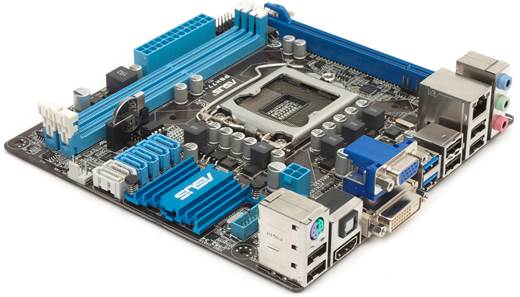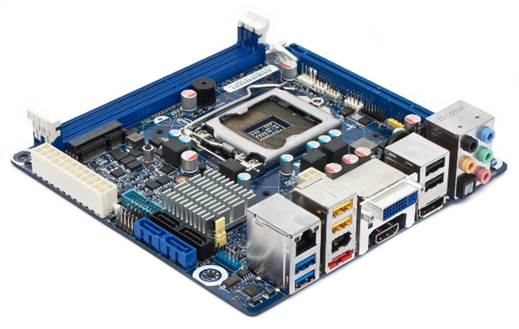The H77 boards
These boards are targeted at mainstream
users, for whom overclocking matters little. It is identical to Z77 chipset in
all aspects other than overclocking and PCI express graphics: Z77 has support
for 1x PCIe x16 or 2x PCIe x8 whereas H77 sup-ports only a single PCIe x16 slot.
Splitting of PCIe lanes is pointless as far as mini ITX form factor boards is
concerned, as most of the boards will have only one PCIe x16 slot. As far as
the mini-ITX boards are concerned the only advantage Z77 chipset-based boards
have over H77-chipset boards is sup-port for overclocking. You can overclock a
processor on an H77 chipset only to a certain extent by changing the base
clock, but multiplier is locked. Gains by overclocking on an H77 board aren’t
much as compared to that on the Z77 board.

ASUS
P8H77-I
We got three boards: ASUS P8H77-I, Intel
DH77DF and Gigabyte H77N-WiFi in this category. Layout-wise the Giga-byte board
looks similar to the Intel board. ASUS P8H77-I has a slightly different layout
with the DIMM slots located slightly on the inner side as the 24-pin ATX power
connector occupies the space on the edge. Although, the CPU socket region is
surrounded by the DIMM slots on the left and PCIe slot on the right, it may be
an issue if you are using a large CPU cooler, but considering most users
looking at an H77 rig will not be indulging in overclocking, the stock cooler
will fit just fine. You may have to insert the memory sticks after installing
the cooler though.

Intel
DH77DF
All the boards lack a heat-sink over the
VRM indicating its lower power profile but the chipsets have a passive
heat-sink. Thanks to the absence of a heat-sink around the VRM circuitry, there
is ample room around the CPU socket. We did not like the placement of all the
headers and fan connectors along the PCIe slot on the Intel DH77DF. The
Gigabyte board was the best in terms of layout, with ASUS being the second
best. ASUS does manage to pack in six SATA ports (2xSATA 3 and 4xSATA 2) which
is impressive. As expected, all SATA ports are pointing upwards. The presence
of a Wi-Fi adapter on the Gigabyte H77N board differentiates it from the other
two boards. The Intel board does have a mini-PCIe slot to add in a Wi-Fi card
though. Coming to the back-panel IO, all three boards provided quite a variety.
The Gigabyte board sports two LAN ports, a Wi-Fi antenna, two USB 3.0 ports
along with three display outs (2xHDMI, 1xDVI). Intel shows some variety in
terms of an eSATA port, a FireWire port and three display outs (DVI, HDMI, DisplayPort).
Finally, ASUS has the standard set of ports including two USB 3.0, six USB 2.0
and three display outs (DVI, D-Sub and DisplayPort). The graphical BIOSes on
the Gigabyte and the ASUS boards is quite impressive as compared to the regular
BIOS on the Intel DH77DF.
The H61 boards
The H61 boards are the lower end of the
Intel chipset spectrum. The H61 chipset is ide-ally meant for lower-budget
builds and meant for those who will use it for an HTPC build or office work.
With the lack of native USB 3.0 support and no support for SATA 3 speeds, this
board has its limits. There are board manufacturers who add a separate chip to
allow USB 3.0 ports on the back panel IO, but that’s about it. It also lacks
RAID support and SSD caching. We got around four boards in this segment namely:
Intel DH61DL, MSI H61I-E35, ASUS P8H61-I and Foxconn H61S. Of these four
boards, you can forget gaming on the MSI H61I-E35 and Intel DH61DL as they lack
a dedicated PCIe x16 slot and instead have a PCIe x1 slot. The ASUS and Foxconn
board each have a PCIe x16 slot (Gen 2). Clearance around the CPU region in the
Intel, MSI and Foxconn board is much better than that on the ASUS board. But
this again will matter only if you are using a large CPU cooler, which is
pointless on such a board as you will not be doing any overclocking. None of
the boards have any heat-sinks around the VRM circuitry. Heat-sinks on the
chipset are present on all boards with the Foxconn and ASUS ones being slightly
better off than the rest. The Fox-conn board has just two SATA 2 ports, whereas
MSI and ASUS boards have twice that. All the ports point upward, but their
alignment is different on all the boards. While ASUS sticks to the more
standard way of arranging them in a line, MSI has them arranged one beside the
other in a horizontal manner which may seem strange, but it does give room for
the SATA cables. Also it can afford to do that as it has a PCIe x1 slot.
Coming to the backpanel ports, there isn’t
much happening really as compared to theZ77 andH77 boards. The Intel board
sports a parallel port, making it an ideal board to be used for office work,
but it is good to see two USB 3.0 ports, a D-Sub and a DVI port as well. The
USB 3.0 port on the Intel board is thanks to the Renesas NEC chip. ASUS is the
only other H61 board that sports two USB 3.0 ports thanks to the Asmedia
controller chip. Since the DH61DL board does not sup-port the Intel Core
i7-3770K, we had called in for an Core i5-3540S. Despite updating the BIOS, we
were facing a lot of issues so we had to use a second generation Core i5-2500K
for the benchmarks. Naturally, its scores will be lower as com-pared to 3rd gen
processors. Other H61 boards worked fine with the Core i7-3770K after a BIOS
update.
Verdict
We decided to divide the boards according
to the chipsets on which they were based to be fair to all participants. Among
the A75 boards, there was a close fight in terms of value for money between the
two boards. The ZOTAC A75-ITX has a huge advantage in the form of an on-board
Wi-Fi connector, but its available for $1,800 more than the ASRock A75M-ITX.
Thousand rup-pees is a huge price gap when you are considering buying mini ITX
boards. Hence, the ASRock A75M-ITXwas awarded the Best Buy.
The H61 boards had a close fight between
Intel, MSI and Foxconn but Foxconn H61Swas awarded the Best Buyaward for its
economical pricing. For an H61 board, the Foxconn board provides ample features
including a PCIe x16 slot which was lacking in the MSI and Intel boards. The
ASUS board has the larger overall score, but it is also priced the highest.
Among the H77 boards, Gigabyte and ASUS had
a close fight with the overall score difference of just over two points.
Gigabyte has an advantage with the on-board Wi-Fi module, but the pricing is
way off the charts. At almost $3,750 over the ASUS board, it just makes ASUS
P8H77-Ithe Best Buy.
Finally, in the high-end mini ITX category,
we had three wonderful boards battling it out. ASUS P8Z77-I Deluxe bagged the
Editor’s Pickaward for its highest overall score, a killer feature set and an
innovation that was not seen on any other mini-ITX board we have tested to
date. The overclocking prowess of the ASUS board is way better than that of the
ASRock and ZOTAC Z77 boards. ZOTAC Z77-ITX A-E was awarded the Best Buy for its
bang for the buck offerings and a very sweet pricing.